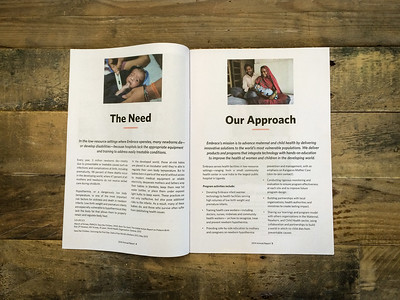Our world is packed with information, too much at times. When I was growing up, we just had a few TV channels to choose from. Now there are countless streaming options. We also have email, the internet, and social media, just to name a few. It’s a lot!
How does your nonprofit organization compete with all this? You need to communicate regularly with your donors and you need to do it well. But in this sea of information, they might miss your messages.
Here are a few ways you can make your messages stand out and get noticed.
What’s your intention?
What’s the purpose of your message? What do you want your reader to do? Are you asking for a donation? Maybe you’re thanking your donor or sharing an update.
Think from your reader’s perspective. What would she be interested in or what would make him take action?
Don’t muddle your messages with too much information. Keep it simple and stick to one call to action or type of message. If you ask someone to make a donation, volunteer, and contact their legislators in the same message, they may not do any of that.
Choose the right channels
Most likely you’ll use more than one channel to communicate. Pay attention to the channels your donors are using and focus your efforts there.
Email may be your primary mode of communication and there’s a reason for that. It’s fast, easy, relatively inexpensive, and almost everyone has an email address. You can quickly get a message out to a lot of people. Also, unlike social media, it’s something you can control. You don’t have to rely on a social media algorithm to hope your message ends up in your donor’s feed.
The downside is people get an enormous amount of email from a variety of different sources. Political organizations and candidates here in the U.S. send a ton of email messages and it’s only going to get worse as the 2024 election approaches. I tend to ignore a lot of those emails and then end up missing something important. Plan a strategy to help you break through the noise.
Plus, the average email open rate is around 20%. And, social media is often just a lot of a lot.
You can see how easy it is for your electronic messages to get lost in the shuffle. Your donors may just tune things out, even if you have something engaging to share.
While you’ll likely use electronic communication pretty regularly, don’t discount direct mail. Your donors are more likely to see these messages. We get far less postal mail than electronic communication. Also, someone can put a piece of mail aside and look at it later. Don’t count on that happening with any type of electronic communication. You can also communicate by phone. This is a great way to thank your donors.
Going multichannel is usually your best bet. This is very common for fundraising campaigns and inviting people to events, as well as including a link to your email newsletter on your social media platforms. This way if people miss your initial message on one platform, they may see it on a different one. You’ll also want to send regular reminders for fundraising appeals and event invitations.
Get noticed right away
Your donors have a lot going on and you need to capture their attention right away.
Your fundraising letters and anything else you send by mail need to look appealing enough to open. You could put a tagline on the envelope. That doesn’t mean something like It’s Our Annual Appeal. Try something like – How you can help families move into their own homes. or THANK YOU!
Your envelope should look personal and not resemble a bill or junk mail. A few ways to make your mail stand out are to use something other than the usual white business envelope, hand address your envelope, and use stamps.
Once your donor opens your fundraising appeal, lead with a story followed by a clear, prominent ask. When they open your thank you letter, they should be greeted with gratitude.
A good subject line is the key to getting someone to open your email message. Keep in mind that your donor’s inbox is bursting with messages. Don’t use something boring like April e-newsletter or Donation Received. Entice them with Learn how you helped the Stevens family find their own home or You just did something amazing today! Putting someone’s first name in the subject line can also help with open rates.
Keep them engaged once they open your message.
Keep it short
In many cases, a shorter message is best. You want a good balance between saying too much and saying too little. All your words should count, so be careful about adding too much filler. That often includes bragging about your organization and explaining what you do.
Keep in mind the average human attention span is about eight seconds.
Your goal is to get your donors to read your messages. If it looks long and boring, they probably won’t bother.
Make it easy to read and scan
Besides sending a short message, use short paragraphs and lots of white space, too. Your messages need to be easy to read and scan in an instant. Most people aren’t going to read something word for word. Be sure they can quickly get the gist of what you want to say. Don’t use microscopic font either – use 12 point or higher.
Be personal and conversational
Write directly to your reader using clear, conversational language – no jargon. Don’t confuse your donors with generic messages.
Don’t cast a wide net
It’s important to send your messages to the right audience and your audience isn’t everyone.
You’ll have more luck with a fundraising appeal when you send it to past donors or people who have a connection to your cause. The same is true for event invitations or recruiting volunteers.
You may want to reach out to as many people as possible, but that won’t guarantee you’ll get more donations or event attendees. Segmenting and engaging with the right audience will bring you better results.
Be a welcome visitor
If you communicate regularly and do it well, your donors should recognize you as a reputable source and are more likely to read your messages. If all you do is send them generic fundraising appeals, prepare to be disappointed.
When you send email, make sure people know it’s coming from your organization. In the from field, put DoGood Nonprofit or Nancy (Jackson), DoGood Nonprofit. If you just put a person’s name, people may not know who it’s from and ignore your message, unless that person is well known to your readers.
Only send email to people who have opted into your list. Otherwise, you’re spamming them. Some people will choose not to receive email from you and that’s okay. The ones who do are interested in hearing from you. Give people the option to unsubscribe, too. Measuring your email metrics will help you communicate more effectively.
When you send email, it’s important to strike a balance between being known and being annoying. Unlike the political organizations I mentioned above, many nonprofits don’t communicate enough. Be sure to reach out anywhere between once a week and once a month.
Even though people only get a few pieces of mail a day, most of it’s junk mail. You never want any of your letters, newsletters, or postcards to be perceived as junk mail (see above).
By putting in a little time and effort, you can help ensure that your messages stand out in a sea of information.










